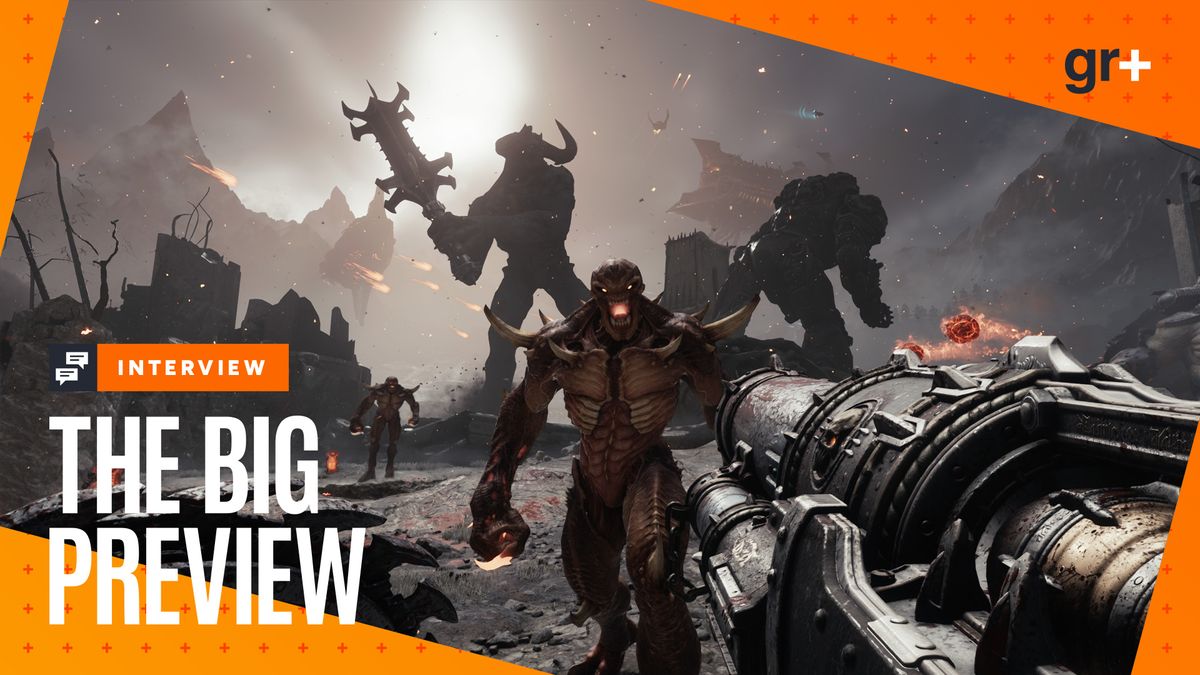
When you think of Doom it’s easy to think about massive demons and huge guns. But, though combat has often been frantic even back in the 1993 original, how you deal with a room full of hellspawn has always been something of a dynamic puzzle. How do you take out demons efficiently with the tools available to you while conserving resources like ammo and health? Doom: The Dark Ages wants you to think about that more than ever with its revised combat loop that combines shield, melee, and its ever-iconic guns.
“The development of the loop is the trade-offs, and the things that make it a risk and a reward – all of that. It’s fun to play off of those things,” says Doom: The Dark Ages executive producer Marty Stratton. “I often throw the shield and lock them down for a second, take somebody out, and then when you recall it, immediately lock on to that target again and smash into them before they can recover. As you then dive into those mechanics and understand the nuances of how the AIs react to each of them, you learn how to stack the abilities on top of each other.”
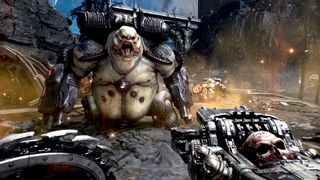
“Typically, there’s what you want to do, there’s what the tool can do, and the space in between is filled with player skill,” says game director Hugo Martin on how players have to balance all of this in the moment. “If a heavy-hitting weapon takes out a ton of guys, then it slows down my movement – so I have to be smart about how I use it. That’s where it becomes really engaging.”
Big Preview
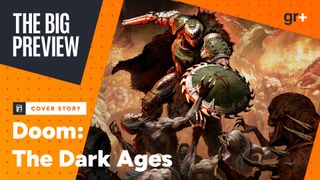
Our Doom: The Dark Ages Big Preview is here, focusing on exclusive access and deep dive insights into id Software’s latest over-the-top FPS
Doom is synonymous with the BFG – a massive, screen-destroying rocket launcher in the original game. But even strong weapons need to make players think, even if it’s just about when to deploy it. “If you have a super powerful weapon, and there’s no cost to using it, then it’s fun, but it starts to feel like a tech demo, you know?” says Martin. “You’re just slaughtering everything. Usually those kinds of experiences don’t have a lot of long term engagement. They’re not very sticky.”
By forcing players to consider the risk and reward of every weapon before they pull the trigger, or what having your shield in mid-air instead of at your side means before you hurl it, id Software makes players more immersed. “You’re always making decisions, right? Locked down [with the shield], but at this expense, now I have to move… Which keeps you thinking, and when you’re thinking, you’re engaged, which is what we always want the player to be doing.”
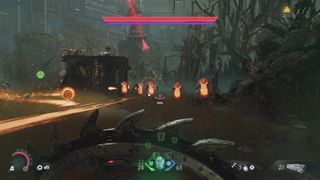
The modern Doom series, beginning with Doom in 2016 and its sequel Doom Eternal in 2020, have done a great job making its combat loop system clear to players. Finishing off enemies one way might get you health pickups, another method of violence turns them into a soup of ammo to hoover up, or might score you new armor.
With Doom Eternal, though, the loop evolved – but it also felt more complicated. On top of additions like the flamebelcher and shoulder-mounted launcher, multiple alt fire modes for weapons could be used to open up enemy weak points. It was great when you got used to it, but playing it right felt like you had to constantly press just the right buttons all over the control as if you were belting out a mean saxophone solo. Doom: The Dark Ages doesn’t just simplify some of this, but introduces the shield saw as an ever-present tool across the left-side of the controller as a lynchpin for the Doom Slayer’s hyper-violent action.
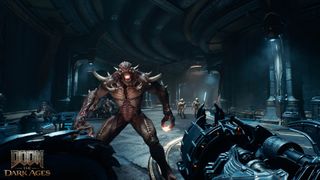
“What’s happening under the hood, as far as the control scheme and the way that the shield is [to use], its behavior is contextual based on what you’re aiming at,” says Stratton. Raise your shield to block, for instance, and reticules will appear on enemies you can charge towards. Throw the shield, meanwhile, and it’ll know whether to cleave through weak goons as it boomerangs back to you; and also when to embed itself into a stronger enemy to lock it in place.
Stratton notes the fact you always have your fingers near the buttons for the shield at all times calling it “ergonomical design, streamlined controls” – it’s never a problem to turn your intention into action. “You think, so you act on your thoughts, but you don’t have to struggle with the complexity of buttons on the controller, it feels pretty natural. And really, it’s just a matter of: I see this enemy, do I want to do this?”
“You’re executing combos like you did in Eternal but [with] the control scheme being more streamlined, it feels more intuitive,” adds Martin. “The actions we’re asking you to perform, it’s really just three core abilities of shield play – your shield, melee, and guns. You exploit weaknesses with your shield, you replenish resources with your melee, and then you hurt things with your guns.” You don’t simply move from one to the next, either. Each of those pillars of combat feed back into each other, especially as you upgrade them and choose additional abilities.
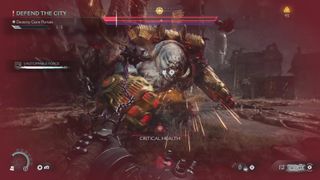
“For example, perform melee attacks while using the skull crusher, it will feed the charge. And once it’s fully charged, it lights up yellow and it fires at a faster rate. It feels amazing,” says Martin. “But in order to ride that wave of power, you have to keep using your melee weapon and/or executing enemies…”
“Which is charged by parrying!” Stratton chimes in, making a whirring noise and miming a circle in the air – the cycle continues, and the combat loop continues to rip and tear its way forward.
“Exactly. There’s a synergy between the tools. That’s what we focus on. This combat loop that generates this flowstate that, despite the chaos, gives you something to master,” says Martin. “These are new tools you’ve never used before in a Doom game, you learn them, and then in the second half of the game, you start diving into the progression of the weapon, and you start mastering the tools.”
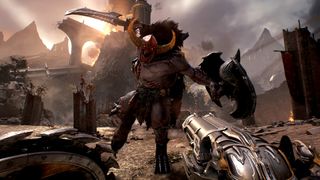
Id Software has described the last two Doom games as having combat puzzles, rewarding you for mastering their loop with a sense of battle arena domination. “I think that was the strength of Eternal, once you get into the loop of chainsaw, flame belch, guns,” says Martin. But in Doom: The Dark Ages, with shield and melee elevated, the timbre of the notes you’re hitting chime a little different this time around. “As you saw in this demo, quick switching is not a requirement in this game. The guns are more like rhythm guitars this time, you can hang with them and sustain a good level of damage, and you feel strong with any one of the weapons,” he adds. “You could literally play and beat an entire level with one gun. So you switch to guns more depending on preference.”
The deeper you get into upgrades, the more you can get out of your toolkit of violence. “It becomes a little bit of a build because you have three different melee weapons. For example, melee feeds the charge of the skull crusher,” explains Martin. “Well, the mace, the last melee weapon in the game, has limited charges. You can only hit guys with one swing at a time […] So if you’re smart, you’ll switch back to gauntlets when you’re using the skull crusher, because those charge up faster, hit lighter, but you have three charges.”
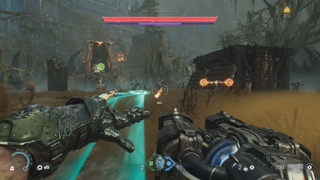
Different upgrades for guns can affect how they can combo with melee and the shield as well. Shooting an enemy stunned with the shield buzzing in their belly may cause the shots to ricochet. Or, with the rocket launcher, you can make it so after a parry you’re invulnerable to self-inflicted damage with it – making it a high-impact, close-range finisher if you’re skilled enough. Martin even tells me about shield runes that can additionally apply extra effects when you deflect, adding more layers on top.
“All of this feeds off of parrying and the shield inputs, buttons you’ve mastered and been pressing for the last couple of hours. The depth of those tools just continues to expand throughout the game,” says Martin. “It’s contextual. Rather than introducing new buttons, the buttons you’ve mastered just continue to expand on what it is they can do.” Doom: The Dark Ages is about making the most out of every action, and with each button press feeling this explosive, we can’t wait to see how the combat loop further unfurls.


